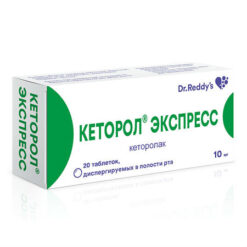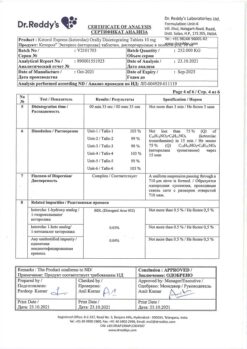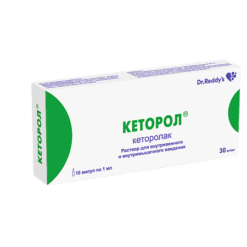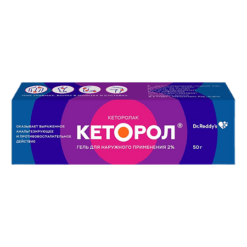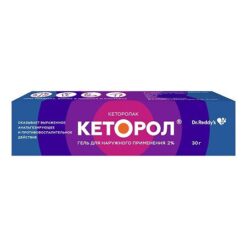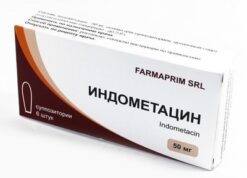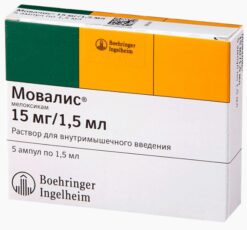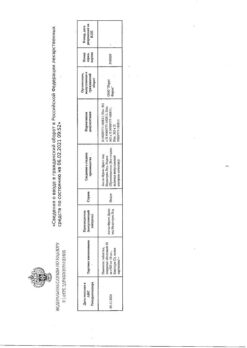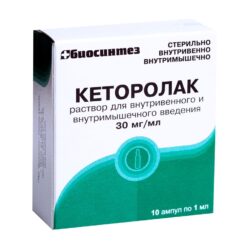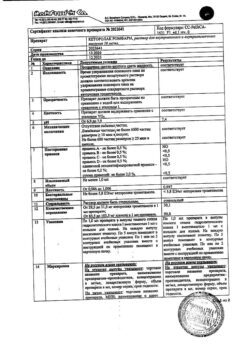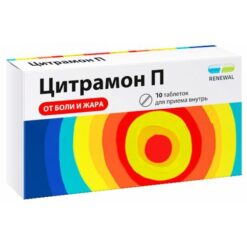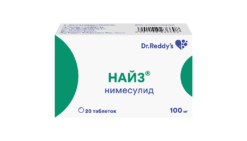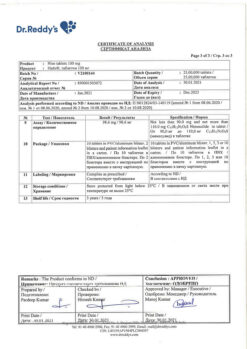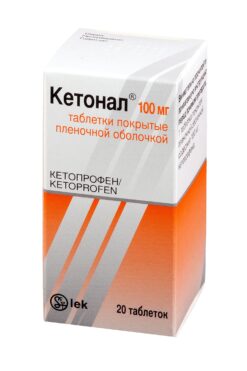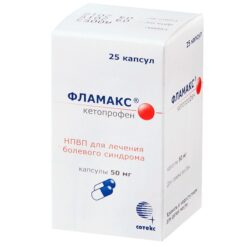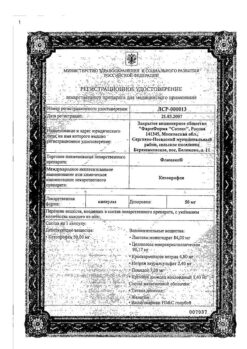No products in the cart.
Ketorol, 10 mg 20 pcs.
€1.00
Out of stock
(E-mail when Stock is available)
Description
Pharmacodynamics
Non-steroidal anti-inflammatory drug (NSAID), has a pronounced analgesic effect, anti-inflammatory and moderate antipyretic effect.
The mechanism of action is related to non-selective inhibition of cyclooxygenase (COX) activity – COX-1 and COX-2, catalyzing formation of prostaglandins from arachidonic acid, which play an important role in the pathogenesis of pain, inflammation and fever.
Ketorolac is a racemic mixture of [-]S and [+]R enantiomers, with analgesic effect due to the [-]S form. By the analgesic effect the drug is comparable with morphine and is much superior to other NSAIDs.
The drug does not affect the opioid receptors, does not inhibit respiration, does not cause drug addiction, has no sedative and anxiolytic effects.
After oral administration the development of analgesic effect is noted in 1 hour.
Pharmacokinetics
When taken orally ketorolac is well and quickly absorbed in the gastrointestinal tract (GIT). The bioavailability of ketorolac is 80-100%, maximum concentration (Cmax) after oral administration of 10 mg is 0.82-1.46 mcg/ml, time to reach maximum concentration (TCmax) is 10-78 min. Fat-rich food decreases the maximum blood concentration of the drug and delays its attainment by one hour. The time of reaching the equilibrium concentration (Css) of the drug in per oral administration of 10 mg 4 times per day is 24 hours and the concentration is 0.39-0.79 mcg/ml. The volume of distribution is 0.15-0.33 l/kg. In patients with renal insufficiency the distribution volume of the drug may increase by 2 times, and the distribution volume of its R-enantiomer – by 20%.
Indications
Indications
Pain syndrome of severe and moderate severity: injuries, toothache, pain in the postpartum and postoperative period, cancer, myalgia, arthralgia, neuralgia, radiculitis, dislocations, sprains, rheumatic diseases.
Pharmacological effect
Pharmacological effect
Pharmacodynamics
A non-steroidal anti-inflammatory drug (NSAID), has a pronounced analgesic effect, has anti-inflammatory and moderate antipyretic effects.
The mechanism of action is associated with non-selective inhibition of the activity of cyclooxygenase (COX) – COX-1 and COX-2, which catalyzes the formation of prostaglandins from arachidonic acid, which play an important role in the pathogenesis of pain, inflammation and fever.
Ketorolac is a racemic mixture of [-]S and [+]R enantiomers, and the analgesic effect is due to the [-]S form. The strength of the analgesic effect is comparable to morphine, significantly superior to other NSAIDs.
The drug does not affect opioid receptors, does not depress respiration, does not cause drug dependence, and does not have a sedative or anxiolytic effect.
After oral administration, the development of analgesic effect is noted after 1 hour.
Pharmacokinetics
When taken orally, ketorolac is well and quickly absorbed from the gastrointestinal tract (GIT). Bioavailability of ketorolac is 80-100%, maximum concentration (Cmax) after oral administration of 10 mg is 0.82-1.46 mcg/ml, time to reach maximum concentration (TCmax) is 10-78 minutes. Food rich in fat reduces the maximum concentration of the drug in the blood and delays its achievement by an hour. Plasma protein binding – 99%.
The time to reach the equilibrium concentration of the drug (Css) when taken orally 10 mg 4 times a day is 24 hours and the concentration is 0.39-0.79 mcg/ml. Volume of distribution – 0.15-0.33 l/kg. In patients with renal failure, the volume of distribution of the drug may increase by 2 times, and the volume of distribution of its R-enantiomer by 20%.
Penetrates into breast milk: when the mother takes 10 mg of ketorolac, Cmax in milk is achieved 2 hours after taking the first dose and is 7.3 ng/ml, 2 hours after taking the second dose of ketorolac (when using the drug 4 times a day) – 7.9 ng/l.
More than 50% of the administered dose is metabolized in the liver with the formation of pharmacologically inactive metabolites. The main metabolites are glucuronides, which are excreted by the kidneys, and p-hydroxyketorolac. Excreted 91% by the kidneys, 6% through the intestines.
The half-life (T1/2) in patients with normal renal function averages 5.3 hours (2.4-9 hours after oral administration of 10 mg). T1/2 increases in elderly patients and shortens in young ones. Liver dysfunction does not affect T1/2. In patients with impaired renal function, with a plasma creatinine concentration of 19-50 mg/l (168-442 µmol/l), T1/2 – 10.3-10.8 hours, with more severe renal failure – more than 13.6 hours.
When taken orally 10 mg, the total clearance is 0.025 l/h/kg; in patients with renal failure (with a plasma creatinine concentration of 19-50 mg/l) – 0.016 l/h/kg.
Not excreted by hemodialysis.
Special instructions
Special instructions
Ketorol® has two dosage forms (film-coated tablets and solution for injection). The choice of method of drug administration depends on the severity of the pain syndrome and the patient’s condition. The risk of developing drug complications increases when the treatment period is extended beyond 5 days and the oral dose of the drug is increased to more than 40 mg/day.
The drug should not be used simultaneously with other NSAIDs (including cyclooxygenase-2 inhibitors), as well as probenecid, pentoxifylline, acetylsalicylic acid, lithium salts, anticoagulants (including warfarin and heparin).
When taken together with other NSAIDs, fluid retention, cardiac decompensation, and increased blood pressure may occur. The effect on platelet aggregation ceases after 24-48 hours.
Patients with blood coagulation disorders are prescribed only with constant monitoring of platelet counts, especially important for postoperative patients who require careful monitoring of hemostasis. The drug may change the properties of platelets. To reduce the risk of developing NSAID gastropathy, antacid medications, misoprostol, and omeprazole are prescribed.
During the treatment period, care must be taken when driving vehicles and engaging in other potentially hazardous activities that require increased concentration and speed of psychomotor reactions.
Active ingredient
Active ingredient
Ketorolac
Composition
Composition
Each film-coated tablet contains:
Active substance:
ketorolac tromethamine (ketorolac trometamol) – 10 mg;
Excipients:
microcrystalline cellulose 121 mg,
lactose 15 mg,
corn starch 20 mg,
colloidal silicon dioxide 4 mg,
magnesium stearate 2 mg,
sodium carboxymethyl starch (type A) 15 mg;
Coverage:
hypromellose 2.6 mg,
propylene glycol 0.97 mg,
titanium dioxide 0.33 mg,
olive green (quinoline yellow dye 78%, brilliant blue dye 22%) 0.1 mg.
Contraindications
Contraindications
Hypersensitivity to ketorolac;
complete or incomplete combination of bronchial asthma, recurrent polyposis of the nose or paranasal sinuses and intolerance to acetylsalicylic acid and other NSAIDs (including a history);
erosive and ulcerative changes in the mucous membrane of the stomach and duodenum, active gastrointestinal bleeding; cerebrovascular or other bleeding;
inflammatory bowel diseases (Crohn’s disease, ulcerative colitis) in the acute phase;
hemophilia and other bleeding disorders;
decompensated heart failure;
liver failure or active liver disease;
severe renal failure (creatinine clearance less than 30 ml/min), progressive kidney disease, confirmed hyperkalemia;
period after coronary artery bypass surgery;
lactase deficiency, lactose intolerance, glucose-galactose malabsorption;
pregnancy, childbirth, lactation;
children under 16 years of age.
With caution:
Hypersensitivity to other NSAIDs, bronchial asthma, coronary heart disease, congestive heart failure, edema syndrome, arterial hypertension, cerebrovascular diseases, pathological dyslipidemia/hyperlipidemia, renal dysfunction (creatinine clearance 30-60 ml/min), diabetes mellitus, cholestasis, active hepatitis, sepsis, systemic red lupus, peripheral arterial disease, smoking, concomitant use with other non-steroidal anti-inflammatory drugs, older age (over 65 years), anamnestic data on the development of gastrointestinal ulcers, alcohol abuse, severe somatic diseases, concomitant therapy with the following drugs: anticoagulants (for example, warfarin), antiplatelet agents (for example, acetylsalicylic acid, clopidogrel), oral glucocorticosteroids (for example, prednisolone), selective serotonin reuptake inhibitors (for example, citalopram, fluoxetine, paroxetine, sertraline).
Side Effects
Side Effects
The frequency of side effects is classified depending on the frequency of occurrence of the case: often (1-10%), sometimes (0.1-1%), rarely (0.01-0.1%), very rarely (less than 0.01%), including individual reports.
From the digestive system: often (especially in elderly patients over 65 years of age with a history of erosive and ulcerative lesions of the gastrointestinal tract) – gastralgia, diarrhea; less often – stomatitis, flatulence, constipation, vomiting, feeling of fullness in the stomach; rarely – nausea, erosive and ulcerative lesions of the gastrointestinal tract (including with perforation and/or bleeding – abdominal pain, spasm or burning in the epigastric region, melena, vomiting like “coffee grounds”, nausea, heartburn and others),
cholestatic jaundice, hepatitis, hepatomegaly, acute pancreatitis.
From the urinary system: rarely – acute renal failure, lower back pain with or without hematuria and/or azotemia, hemolytic-uremic syndrome (hemolytic anemia, renal failure, thrombocytopenia, purpura), frequent urination, increased or decreased urine volume, nephritis, edema of renal origin.
From the senses: rarely – hearing loss, ringing in the ears, visual impairment (including blurred visual perception).
From the respiratory system: rarely – bronchospasm, shortness of breath, rhinitis, laryngeal edema.
From the central nervous system: often – headache, dizziness, drowsiness; rarely – aseptic meningitis (fever, severe headache, convulsions, stiffness of the neck and/or back muscles), hyperactivity (mood changes, anxiety), hallucinations, depression, psychosis.
From the cardiovascular system: less often – increased blood pressure; rarely – pulmonary edema, fainting.
From the hematopoietic organs: rarely – anemia, eosinophilia, leukopenia.
From the hemostasis system: rarely – bleeding from a postoperative wound, nosebleeds, rectal bleeding.
From the skin: less often – skin rash (including maculopapular rash), purpura; rarely – exfoliative dermatitis (fever with or without chills, redness, thickening or peeling of the skin, swelling and/or tenderness of the tonsils), urticaria, Stevens-Johnson syndrome, Lyell’s syndrome.
Allergic reactions: rarely – anaphylaxis or anaphylactoid reactions (change in facial skin color, skin rash, urticaria, itching of the skin, tachypnea or dyspnea, swelling of the eyelids, periorbital edema, shortness of breath, difficulty breathing, heaviness in the chest, wheezing).
Other: often – swelling (face, legs, ankles, fingers, feet, weight gain); less often – increased sweating; rarely – swelling of the tongue, fever.
Interaction
Interaction
A pharmacokinetic interaction with drugs that compete for binding to plasma proteins is possible.
Caution should be exercised when using ketorolac simultaneously with digoxin, phenytoin, lithium preparations, diuretics, cyclosporine, methotrexate, other NSAIDs, antihypertensive and antidiabetic agents.
Overdose
Overdose
Symptoms: nausea, vomiting, renal dysfunction, abdominal pain, development of peptic ulcers or erosive gastritis, metabolic acidosis.
Treatment: gastric lavage, symptomatic therapy. and the introduction of adsorbents (activated carbon). Ketorolac is not sufficiently eliminated by dialysis.
Storage conditions
Storage conditions
At a temperature not exceeding 25 °C.
Keep out of the reach of children!
Shelf life
Shelf life
3 years
Manufacturer
Manufacturer
Dr. Reddy’s Laboratories Ltd, India
Additional information
| Shelf life | 3 years |
|---|---|
| Conditions of storage | At a temperature not exceeding 25 ° C. Keep out of reach of children! |
| Manufacturer | Dr. Reddy's, India |
| Medication form | pills |
| Brand | Dr. Reddy's |
Other forms…
Related products
Buy Ketorol, 10 mg 20 pcs. with delivery to USA, UK, Europe and over 120 other countries.


